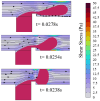Numerical Simulation of Hybrid Electric-Structural Control for Microdroplet Formation in Ribbed T-Junction Microchannels
- PMID: 40731641
- PMCID: PMC12298688
- DOI: 10.3390/mi16070732
Numerical Simulation of Hybrid Electric-Structural Control for Microdroplet Formation in Ribbed T-Junction Microchannels
Abstract
Microdroplet formation in microfluidic systems plays a pivotal role in chemical engineering, biomedicine, and energy applications. Precise control over the droplet size and formation dynamics of microdroplets is essential for optimizing performance in these fields. This work explores a hybrid control strategy that combines an active electric field with passive rib structures to regulate the droplet formation in a ribbed T-junction microchannel under an electric field. Numerical simulations based on the phase-field method are employed to analyze the effects of the electric capillary number Cae and rib height a/wc on the droplet formation mechanism. The results reveal that increasing Cae induces three distinct flow regimes of the dispersed phase: unpinning, partially pinning, and fully pinning regimes. This transition from an unpinning to a pinning regime increases the contact area between the wall and dispersed phase, restricts the flow of the continuous phase, and induces the shear stress of the wall, leading to a reduction in droplet size with the enhanced Cae. Furthermore, an increase in rib height a/wc enhances the shear stress of the continuous phase above the rib, causing a progressive shift from a fully pinning to an unpinning regime, which results in a linear decrease in droplet size. A new empirical correlation is proposed to predict droplet size S/wc2 as a function of rib height a/wc and two-phase flow rate ratio Qd/Qc: S/wc2=(-0.62-1.8Qd/Qc)(a/w)+(0.64+0.99Qd/Qc).
Keywords: electric field; microdroplet formation; microdroplet size; ribbed T-junction.
Conflict of interest statement
The author declares no conflicts of interest.
Figures



















Similar articles
-
Volume of Fluid (VOF) Method as a Suitable Method for Studying Droplet Formation in a Microchannel.Micromachines (Basel). 2025 Jun 27;16(7):757. doi: 10.3390/mi16070757. Micromachines (Basel). 2025. PMID: 40731666 Free PMC article.
-
Short-Term Memory Impairment.2024 Jun 8. In: StatPearls [Internet]. Treasure Island (FL): StatPearls Publishing; 2025 Jan–. 2024 Jun 8. In: StatPearls [Internet]. Treasure Island (FL): StatPearls Publishing; 2025 Jan–. PMID: 31424720 Free Books & Documents.
-
Sexual Harassment and Prevention Training.2024 Mar 29. In: StatPearls [Internet]. Treasure Island (FL): StatPearls Publishing; 2025 Jan–. 2024 Mar 29. In: StatPearls [Internet]. Treasure Island (FL): StatPearls Publishing; 2025 Jan–. PMID: 36508513 Free Books & Documents.
-
The Black Book of Psychotropic Dosing and Monitoring.Psychopharmacol Bull. 2024 Jul 8;54(3):8-59. Psychopharmacol Bull. 2024. PMID: 38993656 Free PMC article. Review.
-
Hybrid closed-loop systems for managing blood glucose levels in type 1 diabetes: a systematic review and economic modelling.Health Technol Assess. 2024 Dec;28(80):1-190. doi: 10.3310/JYPL3536. Health Technol Assess. 2024. PMID: 39673446 Free PMC article.
References
-
- Chong W.H., Huang Y., Wong T.N., Ooi K.T., Zhu G.P. Magnetic nanorobots, generating vortexes inside nanoliter droplets for effective mixing. Adv. Mater. Technol. 2018;3:1700312. doi: 10.1002/admt.201700312. - DOI
-
- Zheng L., Liu X., Yang G., Liu J., Jiang B., Liu Y., Li X., Hu X., Zhang Z. Highly efficient synthesis of cyclic carbonates via deep eutectic solvents from CO2 at the gas-liquid interface of microdroplet under atmospheric pressure condition. Chem. Eng. Sci. 2024;289:119867. doi: 10.1016/j.ces.2024.119867. - DOI
Grants and funding
LinkOut - more resources
Full Text Sources

